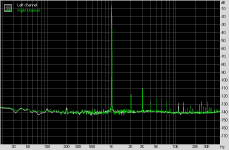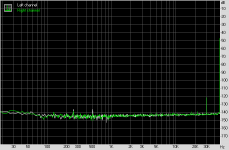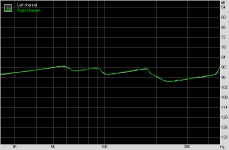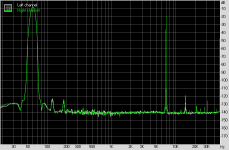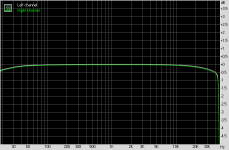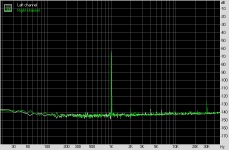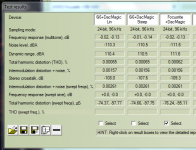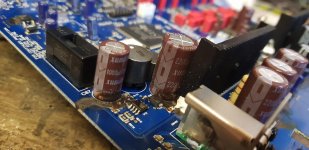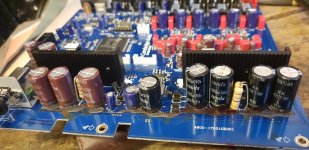Thread revival...!
Is the Dac magic still deemed a decent piece of kit or can better performance be had from Ali/eBay boards with more up to date chips.?
I have one....obtained recently. I like it but have no other benchmarks.
Quick one.....the output coupling caps...470uf 16v. Thwy are bipolar and many suggestions here to swap out for Pans FC etc.....but I only see these in polarised.
Is adding a polarised cap ok and if so doesn't matter which way I mount it?
On my old dacmagic I changed nearly all the caps, put an audio gd clock and some burson op amps as well as dexa regulators on one side. The sound was very good. However there seems to be a design flaw as there was overheating on this model. some used a 9v power supply to make it cooler. Eventually mine died. Took it to a repair guy who said he couldn't fix it, one of the resistors kept on frying. so opened it myself and changed the regulators but no go. Decided to buy a second hand DAC and bought the teac ud 301. Very decent sound but added adapters on the op amps and added two burson vivids on the I/V section , had to buy the extentions so would fit. also bought some Chinese discrete op amps and lm4562 for the other op amp sections. I measured the caps and half of them were not good for ESR so changed them with Panasonic FR caps. The sound is really impressive after the mods. Oh forgot the teac also does DSD on usb, a software provided by teac on your pc is used to play the files. Sound is very good. There are no preset filters but you can upsample in stages up to 192 khz or not upsample anything and the unit keeps very cool unlike dacmagic.
Last edited:
What you recommended is not. In the future you should find out the true capabilities by obtaining a schematic and looking at the parts in the signal path. You should also look at the power cleaning capabilities. Adding a couple film caps and upping the voltage will not clean a switching power supply. Actually you wasted your money.
Are you saying to have a schematic for Katana? I don't think so. You obviously haven't read the user manual either, or you would know the +-15v inverter can be disabled and bypassed (and you would know exactly how to do it), which is how I recommend to use it. In addition, it is an ES9038Q2M based dac, and can play high resolution files as do other all other ES9038xxx based dacs. Also, you don't know if I wasted any money or not, you are making another assumption there too. Lastly, I have no further interest in wasting time trying to correct false information. You are now on my ignore list. Good day.
Last edited:
Hey guys let's all get along....it is Christmas after all!
I appreciate all the comments and Mark's input about the Allo was interesting as I have just acquired an Rpi3b+ with a hifiberry dac+pro. It does seem to sound nice but haven't A/B against the Dacmagic yet.
I am an objective listener as opposed to a subjective measurer. I have no scope or REW etc.
So to this comment Ajcrock.....these are for C1,2, 40, 41, 296 and 299. Assuming I wish to do this to rca and xlr? And this is your recommendation over all the other posts suggesting to replace th3se caps with 470uf Muse ES or similar?
My very limited knowledge tells me that the 1uf are the next step back from a full shirt of these cap positions?
Thanks again
Jim
I appreciate all the comments and Mark's input about the Allo was interesting as I have just acquired an Rpi3b+ with a hifiberry dac+pro. It does seem to sound nice but haven't A/B against the Dacmagic yet.
I am an objective listener as opposed to a subjective measurer. I have no scope or REW etc.
So to this comment Ajcrock.....these are for C1,2, 40, 41, 296 and 299. Assuming I wish to do this to rca and xlr? And this is your recommendation over all the other posts suggesting to replace th3se caps with 470uf Muse ES or similar?
My very limited knowledge tells me that the 1uf are the next step back from a full shirt of these cap positions?
Thanks again
Jim
. So a 1uf will do. Here is a surface mount from Mouser. SMDIC04100TB00KQ00 WIMA | Mouser. Part number SMDIC04100TB00KQ00. Or you can use this one from Panasonic ECW-FD2W105Q1 Panasonic | Mouser. Part number ECW-FD2W105Q1. The main thing is that it is Polypropylene (PP) or PPS.
The coupling capacitor change can be applied to any of the coupling caps. Just use the formula I provided. If the coupling cap is going directly into another chip look up the datasheet and look at the input impedance using the lowest number offered.
As to voltage increases you need to see what the voltage is supplying. For example USB DACs often use the voltage straight off the switching power supply. DACs typically can only handle 3.3 or 5 volts. A fight over the access voltage would fry a resistor
As to the speed of a DAC you need to consider all the chips in the system. In a DAC you have the connectors, the receiver, than the DAC chip. Breaking this down a USB connector only handles 48khz 16bit. Coax is 192. Optical may be 96 or 192. The CS8416 used in the DAC magic is capable of 192kHz, just query the datasheet. Raspberry PI and Arduino based systems are only capable of 48kHz. This is a processor limitation. A simple query of a review showed this information as well as the limit. That and I work with this stuff
Now before someone shouts MQA take a look at how that is done. The data still goes through the receiver which is limited to 192. Inside the DAC the data is upsampled, for lack of a better term. This is handled by another chip.
So the key take away from all the above is that datasheets sheet and formulas are your friends and you need to consider all the parts in the system.
As to voltage increases you need to see what the voltage is supplying. For example USB DACs often use the voltage straight off the switching power supply. DACs typically can only handle 3.3 or 5 volts. A fight over the access voltage would fry a resistor
As to the speed of a DAC you need to consider all the chips in the system. In a DAC you have the connectors, the receiver, than the DAC chip. Breaking this down a USB connector only handles 48khz 16bit. Coax is 192. Optical may be 96 or 192. The CS8416 used in the DAC magic is capable of 192kHz, just query the datasheet. Raspberry PI and Arduino based systems are only capable of 48kHz. This is a processor limitation. A simple query of a review showed this information as well as the limit. That and I work with this stuff
Now before someone shouts MQA take a look at how that is done. The data still goes through the receiver which is limited to 192. Inside the DAC the data is upsampled, for lack of a better term. This is handled by another chip.
So the key take away from all the above is that datasheets sheet and formulas are your friends and you need to consider all the parts in the system.
USB-1 could do 24/96 audio unidirectionally, or 24/48 bi-directionally, IIRC. That is because USB-1 was limited to 12 Megabits/second. USB-2 data rate is 480 Megabits/second, thus allowing multiple channels of 24/192 audio, or fewer channels of at even higher sample rates.
The first versions of RPi were limited to 16/48 audio. RPi 3b or 3b+ is capable of at least single stereo-channel 24/384 I2S audio streaming.
The first versions of RPi were limited to 16/48 audio. RPi 3b or 3b+ is capable of at least single stereo-channel 24/384 I2S audio streaming.
Last edited:
Are you just trying to show us that you know more than everyone else and you are always right. Perhaps you should design and build a DAC from scratch and show us you good your skills are.
Once again consider the whole chain. Find a USB Audio transmitter and receiver that will handle those speeds for audio. Then find a computer that you can modify so you can send those rates. Oh and deal with the jitter while you are at it.
Since none of the above exists then the speed is 48kHz.
I think I answered the original question that was asked and consider this subject closed
Once again consider the whole chain. Find a USB Audio transmitter and receiver that will handle those speeds for audio. Then find a computer that you can modify so you can send those rates. Oh and deal with the jitter while you are at it.
Since none of the above exists then the speed is 48kHz.
I think I answered the original question that was asked and consider this subject closed
Finally got in the thing.
I take it these caps are leaking?!
All seem to be the Xunda brand that have let go. Still seems to work and sound nice. But hopefully this means my mods will make great gains in SQ!

I take it these caps are leaking?!
All seem to be the Xunda brand that have let go. Still seems to work and sound nice. But hopefully this means my mods will make great gains in SQ!
An externally hosted image should be here but it was not working when we last tested it.
Attachments
Yes, flexible and cheap construction adhesive. This is necessary on tall, leaded components to ensure reliable operation after the likely vibration and rough handling during assembly, transport, warehousing etc. I doubt leaking electrolyte would ever look or feel so much like this hasty squirt and smear from a glue gun anyway.
I am just starting out on this journey. So far have done the XLR - RCA conversion. Can A/B the 2 sets of output and there is a nice reduction of hf sibilance. There is still some but less. Next will be wire across the output caps. Where do I test if there is dc present ? With signal going through the unit ?
cheers
cheers
Just bypassed the 6 output caps and 1st thing I notice is the increase in harshness in the highs, then I realise there is more of everything. Soundstage and clarity is improving, just need to move on to the opamps, regulators and some decoupling to smooth out the hf noise/distortions.
Ok -editing these comments 10mins later... the whole sound is more immediate / dynamic...not concerned by the last change. (bypassing output caps).
Ok -editing these comments 10mins later... the whole sound is more immediate / dynamic...not concerned by the last change. (bypassing output caps).
Last edited:
Hi To you All
Thank for all the great information and discussion regarding the CA Dacmagic.
I am an electrical "Plumber" ie I have a basic understanding of electronics, schematics and can replace parts mostly competently. I did "Stress" test a Nichicon muse ka cap by inverting the polarity, man that is one tough cap! Slight bulge but no burst, went from 1000uf to 798uf after 3hours of "burn in". I kept thinking it sounded better before!
I have started to perform many of the mods and the improvements are apparent. I have two, one that I got years ago and refound a month ago and a used one that I got to mod. My mod. version was clearly of (a lot) lesser sound quality. It has now equaled my original, and is starting to be better sounding. Dac 1 started out amazing, it must have been one of the "Review quality" ones. FIY Dac1 is an early serial No. c508xxxxxxx... and Dac2 is later c608xxxxxx.. . I am using the balanced outputs to my pre.
I replaced all the electrolytics, they were (fum)Xunda brand, and the 3, 78xx/79xx regulators.
All of the original caps were within spec but one 2200uf, (by the way +-20%, mostly -, although the non-polar 10uf's were 1uf high).
FYI the field of 10uf polar caps made a big difference. I started at the inputs and moved around the board and compared the sound to Dac1 and used memory for dac2. Having a reference really helped. I also mounted the mkp4 caps (next to the 470uf/16v) on the underside which left more room for 470uf/16v nonpolar replacements.
I have 3 or 4 questions
1st) Is there a current link to the service manual, none seems to work?
2nd) Is the lm317 outputting 3volts(that is what it looks like to me), would slightly higher, ie. 4 or 5volts be more optimal.
3rd) around pg.47 post 462 there is discussion re. digital input cap removal, c17/18 is this worthy of doing and if so should they be bypassed?
thank you Jan
Thank for all the great information and discussion regarding the CA Dacmagic.
I am an electrical "Plumber" ie I have a basic understanding of electronics, schematics and can replace parts mostly competently. I did "Stress" test a Nichicon muse ka cap by inverting the polarity, man that is one tough cap! Slight bulge but no burst, went from 1000uf to 798uf after 3hours of "burn in". I kept thinking it sounded better before!
I have started to perform many of the mods and the improvements are apparent. I have two, one that I got years ago and refound a month ago and a used one that I got to mod. My mod. version was clearly of (a lot) lesser sound quality. It has now equaled my original, and is starting to be better sounding. Dac 1 started out amazing, it must have been one of the "Review quality" ones. FIY Dac1 is an early serial No. c508xxxxxxx... and Dac2 is later c608xxxxxx.. . I am using the balanced outputs to my pre.
I replaced all the electrolytics, they were (fum)Xunda brand, and the 3, 78xx/79xx regulators.
All of the original caps were within spec but one 2200uf, (by the way +-20%, mostly -, although the non-polar 10uf's were 1uf high).
FYI the field of 10uf polar caps made a big difference. I started at the inputs and moved around the board and compared the sound to Dac1 and used memory for dac2. Having a reference really helped. I also mounted the mkp4 caps (next to the 470uf/16v) on the underside which left more room for 470uf/16v nonpolar replacements.
I have 3 or 4 questions
1st) Is there a current link to the service manual, none seems to work?
2nd) Is the lm317 outputting 3volts(that is what it looks like to me), would slightly higher, ie. 4 or 5volts be more optimal.
3rd) around pg.47 post 462 there is discussion re. digital input cap removal, c17/18 is this worthy of doing and if so should they be bypassed?
thank you Jan
Charc, the link I had does not work anymore. Luckily I printed it out while I had the chance.
My Dacmagic journey has completed. I had tried AD825 opamps and found they were a little harsh so replaced them with OPA1612s which are smoother. I have other dacs in the system (Oppo, Foxtel, Focusrite) as well as both outputs from the Dacmagic (the modded Balanced cable -> RCA, vs the unbalanced) and listen to the unbalanced, there is not a huge difference over the other dacs, but the cable mod which eliminates the summing opamp, adds to the dynamics noticeably. That mod is simple, cheap and doesn't require opening the box. Bypassing the output caps is good, but can't remember what it was like before. All in all - very happy with the new Dacmagic.
which output I'm
My Dacmagic journey has completed. I had tried AD825 opamps and found they were a little harsh so replaced them with OPA1612s which are smoother. I have other dacs in the system (Oppo, Foxtel, Focusrite) as well as both outputs from the Dacmagic (the modded Balanced cable -> RCA, vs the unbalanced) and listen to the unbalanced, there is not a huge difference over the other dacs, but the cable mod which eliminates the summing opamp, adds to the dynamics noticeably. That mod is simple, cheap and doesn't require opening the box. Bypassing the output caps is good, but can't remember what it was like before. All in all - very happy with the new Dacmagic.
which output I'm
Hello, greetings from Italy!
I am running mods on my dacmagic (without headphone output and without volume) ... Can you please indicate which are all the diodes to change and with what?
I have the schematic.
Are any Schottky diodes okay or can you opt for SICs that have no switching noise?
Are there SIC in SMD format?
I can opt for to220..I think I have read .. But how do you mount a to220 instead of an SMD?
...thanks .. I attach a photo of my 4 diodes that I see near the heat sinks.
PS:
what model of diodes are mine ... on google i can't find them. which acronym should I look for?

I am running mods on my dacmagic (without headphone output and without volume) ... Can you please indicate which are all the diodes to change and with what?
I have the schematic.
Are any Schottky diodes okay or can you opt for SICs that have no switching noise?
Are there SIC in SMD format?
I can opt for to220..I think I have read .. But how do you mount a to220 instead of an SMD?
...thanks .. I attach a photo of my 4 diodes that I see near the heat sinks.
PS:
what model of diodes are mine ... on google i can't find them. which acronym should I look for?

The Dacmagic pdf says S1D 200V 1A for the diodes. You could maybe bend the bottom of the TO220 legs at 90 degrees to aid soldering onto SMD SMD pads.
I see you have done some cap replacements.
Have you changed any voltage regs yet?
These are in my Aliexpress watch list...might be worth a try for 5v and +/-15.
#Aliexpress £8.17 30%OFF | Lusya SUQIYA-Sigma78 Series LDO Low Noise Step-Down Linear Regulated Power Supply Module T0703
Lusya SUQIYA Sigma78 Series LDO Low Noise Step Down Linear Regulated Power Supply Module T0703|Amplifier| - AliExpress
I see you have done some cap replacements.
Have you changed any voltage regs yet?
These are in my Aliexpress watch list...might be worth a try for 5v and +/-15.
#Aliexpress £8.17 30%OFF | Lusya SUQIYA-Sigma78 Series LDO Low Noise Step-Down Linear Regulated Power Supply Module T0703
Lusya SUQIYA Sigma78 Series LDO Low Noise Step Down Linear Regulated Power Supply Module T0703|Amplifier| - AliExpress
Last edited:
- Home
- Source & Line
- Digital Line Level
- Opening the new DacMagic????
